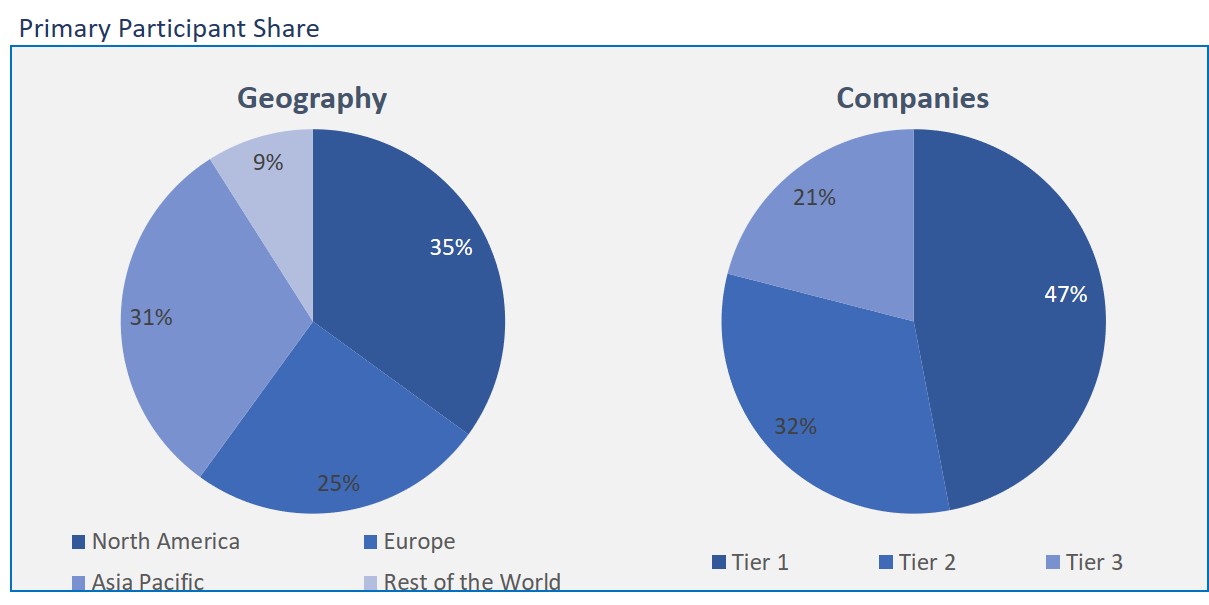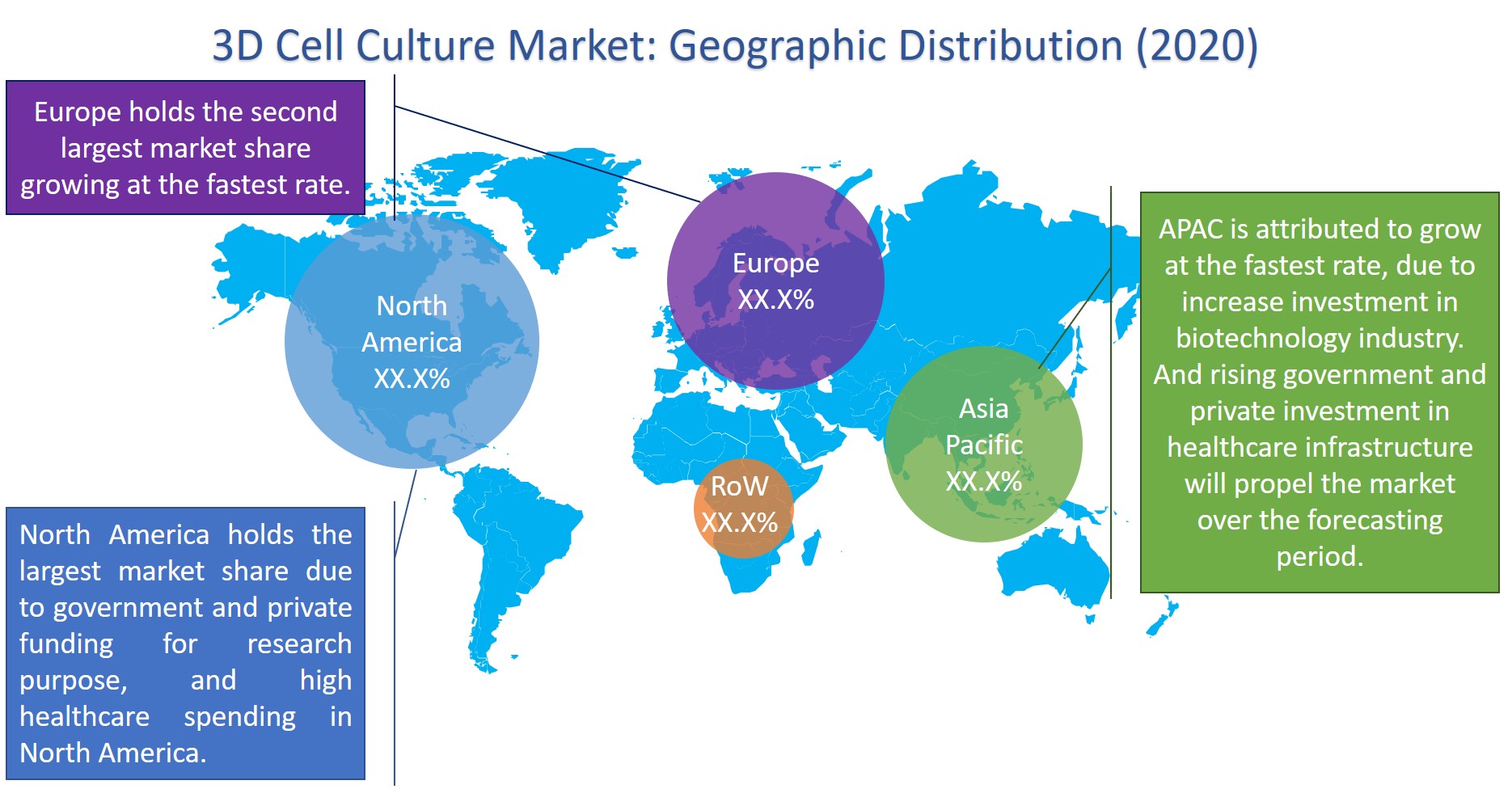
3D Cell Culture Market by Product (Scaffold-based, Scaffold-free, Microfluidics-based, and Magnetic & Bioprinter), Application (Cancer, Stem Cell, Toxicology, Tissue Engineering), End-User (Pharmaceutical & Biotechnology Companies, Research Institutes, and Cosmetics Industry), By Geography (North America, Europe, APAC, and RoW) Global Opportunity Analysis and Industry Forecast up to 2026
- July, 2020
- Domain: Healthcare - Biotechnology
- Get Free 10% Customization in this Report
A 3D cell culture is an artificial environment where biological cells grow or connect with their surrounding habitats in three dimensions. It develops types of different cells and tissues formulation which is not feasible under 2D culture systems. It has more properties of tissue mutation and cell cohesion. The early-stage drug discovery and other related research have earned 3D cell structure increasing popularity which can be seen in its growing application.
Research Methodology:
The 3D cell culture market has been analyzed by utilizing the optimum combination of secondary sources and in-house methodology, along with an irreplaceable blend of primary insights. The real-time assessment of the market is an integral part of our market sizing and forecasting methodology. Our industry experts and panel of primary participants have helped in compiling relevant aspects with realistic parametric estimations for a comprehensive study. The participation share of different categories of primary participants is given below:

3D cell culture is growing at a fast pace in the healthcare environment because of the significant scale of implementations in various areas like cancer research, vitro environment, and regenerative medicine. It has the potential to understand tissue maturation and formation, organogenesis, and cell differentiation has increased its utility. Now animal prototypes in clinical testing and experiments are replaced because of its similarity with cells in vivo. The 3D cell culture market is majorly driven through the increasing usage of 3D cell culture in diagnostic centers, hospitals, pharmaceutical, and biotech companies. Which directly increases the demand for organ transplantation, tissue regeneration, and regenerative medicine.
The research report segregates the market into the following segments:
By Product
- Scaffold-based 3D Cell Cultures
- Hydrogels/ECM Analogs
- Solid Scaffolds
- Micropatterned Surfaces
- Scaffold-free 3D Cell Cultures
- Low Attachment Plates
- Hanging Drop Plates
- 3D Bioreactors
- 3D Petri Dishes
- Microfluidics-based 3D Cell Cultures
- Magnetic & Bioprinted 3D Cell Cultures
By Application
- Cancer & Stem Cell Research
- Drug Discovery & Toxicology Testing
- Tissue Engineering & Regenerative Medicine
By End User
- Pharmaceutical & Biotechnology Companies
- Research Institutes
- Cosmetics Industry
- Other End Users
Some of the prominent companies in the area of 3D Cell Culture are:
- 3D Biotek, LLC
- Advanced Biomatrix, Inc
- Becton
- Dickinson and Company
- Corning Incorporated
- Kuraray Co., Ltd
- Lonza Group Ltd
- Merck & Co., Inc
- Synthecon Incorporated
- Thermo Fisher Scientific Inc
- VWR Corporation.
The report also contains insight regarding technological innovations and advanced solutions for the 3D Cell Culture. The study also gives an in-depth idea about the major competitors in the market, their journey and the competitive edge via systematic analytical tools including SWOT analysis. As per Infoholic Research, the estimated market value of 3D Cell Culture in 2020 is US$ 2,717.6 million and it is predicted that it will grow at a CAGR of 29.1%. There are three important factors which are the driving forces behind the growth of 3D Cell Culture market:

The key features which have fueled its increased its growth are:
- The rise in the prevalence rate of cancer
- Growing Focus on Personalized Medicine
- High Degree of Corporate Inclusion for Research
The physiologic, histologic, and functional properties of the respective tissues have given the homotypic and heterotypic 3D tissue culture models. These properties enhance the different cellular functions such as adhesion, migration, gene expression, and proliferation. The creation of duct-like structures in vitro environments can be formed by two important factors such as normal polarization and differentiation of epithelial cells as well as with the usage of 3D cultures. Moreover, the synergistic effect required for the interactions of cell-cell and cell-extracellular matrix (ECM), which can control the expression of molecules involved in cell differentiation, is also achieved in 3D cell cultures.
The potential that 3D models have so that it can minimize the accompanying flaws with 2D monolayer cultures is predetermined to fuel the demand for these techniques in the near future. The rising demand from the shift of 2D to 3D technology is pushing the growth of this market. In addition, opportunistic marketing competitors are entering this segment due to its high market potential. Subsequently, this will further propel the market.
These technologies provide advanced tools that can help to explore key aspects of disease and enable demonstration of micro-environmental factors that support in-vivo tumor growth. 3D concept of artificial cell cultivation provides vast benefits in the analysis of phenotypic heterogeneity of cancers and heterotypic intercellular crosstalk for 3D Cell Culture vendors to fulfill both the residential as well as commercial sectors.
- Executive Summary
- Industry Outlook
- Industry Overview
- Industry Trends
- Market Snapshot
- Market Definition
- Market Outlook
- PEST Analysis
- Porter Five Forces
- Related Markets
- Market Characterisitics
- Market Evolution
- Market Trends and Impact
- Advantages/Disadvantages of Market
- Regulatory Impact
- Market Offerings
- Market Segmentation
- Market Dynamics
- Drivers
- Restraints
- Opportunities
- DRO - Impact Analysis
- End User: Market Size & Analysis
- Overview
- Pharmaceutical & Biotechnology Companies
- Research Institutes
- Cosmetics Industry
- Other End Users
- Application: Market Size & Analysis
- Overview
- Cancer & Stem Cell Research
- Drug Discovery & Toxicology Testing
- Tissue Engineering & Regenerative Medicine
- Technology: Market Size & Analysis
- Overview
- Scaffold-based 3D Cell Cultures
- Hydrogels/ECM Analogs
- Solid Scaffolds
- Micropatterned Surfaces
- Scaffold-free 3D Cell Cultures
- Low Attachment Plates
- Hanging Drop Plates
- 3D Bioreactors
- 3D Petri Dishes
- Microfluidics-based 3D Cell Cultures
- Magnetic & Bioprinted 3D Cell Cultures
- Geography: Market Size & Analysis
- Overview
- North America
- Europe
- Asia Pacific
- Rest of the World
- Competitive Landscape
- Competitor Comparison Analysis
- Market Developments
- Mergers and Acquisitions, Legal, Awards, Partnerships
- Product Launches and execution
- Vendor Profiles
- 3D Biotek, LLC
- Overview
- Product Offerings
- Geographic Revenue
- Business Units
- Developments
- SWOT Analysis
- Business Strategy
- Advanced Biomatrix, Inc
- Overview
- Product Offerings
- Geographic Revenue
- Business Units
- Developments
- SWOT Analysis
- Business Strategy
- Becton
- Overview
- Product Offerings
- Geographic Revenue
- Business Units
- Developments
- SWOT Analysis
- Business Strategy
- Dickinson and Company
- Overview
- Product Offerings
- Geographic Revenue
- Business Units
- Developments
- SWOT Analysis
- Business Strategy
- Corning Incorporated
- Overview
- Product Offerings
- Geographic Revenue
- Business Units
- Developments
- SWOT Analysis
- Business Strategy
- Kuraray Co., Ltd
- Overview
- Product Offerings
- Geographic Revenue
- Business Units
- Developments
- SWOT Analysis
- Business Strategy
- Lonza Group Ltd
- Overview
- Product Offerings
- Geographic Revenue
- Business Units
- Developments
- SWOT Analysis
- Business Strategy
- Merck & Co., Inc
- Overview
- Product Offerings
- Geographic Revenue
- Business Units
- Developments
- SWOT Analysis
- Business Strategy
- Synthecon Incorporated
- Overview
- Product Offerings
- Geographic Revenue
- Business Units
- Developments
- SWOT Analysis
- Business Strategy
- Thermo Fisher Scientific Inc
- Overview
- Product Offerings
- Geographic Revenue
- Business Units
- Developments
- SWOT Analysis
- Business Strategy
- VWR Corporation.
- Overview
- Product Offerings
- Geographic Revenue
- Business Units
- Developments
- SWOT Analysis
- Business Strategy
- 3D Biotek, LLC
- Companies to Watch
- Greiner Bio-One International GmbH
- Overview
- Market
- Business Strategy
- Promocell GmbH
- Overview
- Market
- Business Strategy
- Advanced Biomatrix, Inc.
- Overview
- Market
- Business Strategy
- Hµrel Corporation
- Overview
- Market
- Business Strategy
- Synvivo, Inc.
- Overview
- Market
- Business Strategy
- Greiner Bio-One International GmbH
- Analyst Opinion
- Annexure
- Report Scope
- Market Definitions
- Research Methodology
- Data Collation and In-house Estimation
- Market Triangulation
- Forecasting
- Report Assumptions
- Declarations
- Stakeholders
- Abbreviations
Research Framework
Infoholic research works on a holistic 360° approach in order to deliver high quality, validated and reliable information in our market reports. The Market estimation and forecasting involves following steps:
- Data Collation (Primary & Secondary)
- In-house Estimation (Based on proprietary data bases and Models)
- Market Triangulation
- Forecasting

Market related information is congregated from both primary and secondary sources.
Primary sources
involved participants from all global stakeholders such as Solution providers, service providers, Industry associations, thought leaders etc. across levels such as CXOs, VPs and managers. Plus, our in-house industry experts having decades of industry experience contribute their consulting and advisory services.
Secondary sources
include public sources such as regulatory frameworks, government IT spending, government demographic indicators, industry association statistics, and company publications along with paid sources such as Factiva, OneSource, Bloomberg among others.
